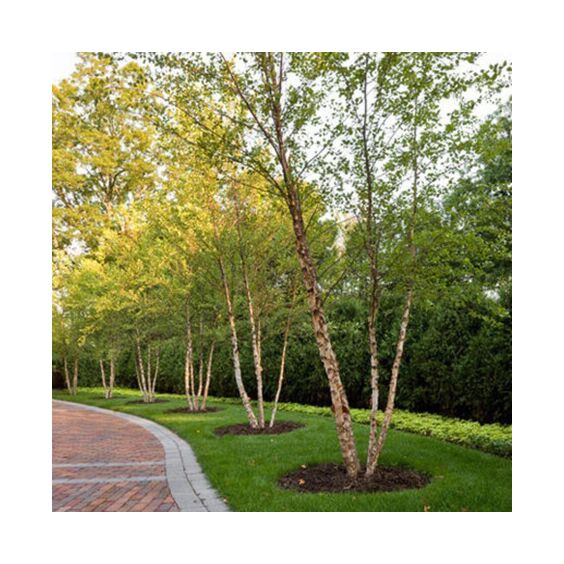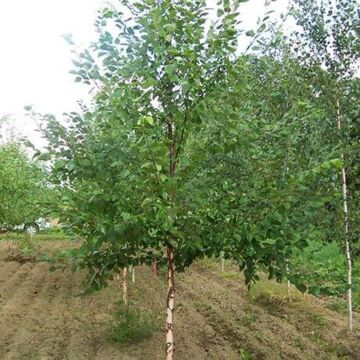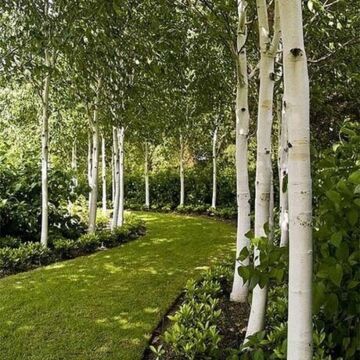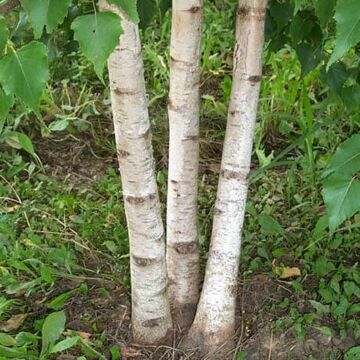
Growing zones
See Zone Map >Status: In stock
Considered one of the best-growing landscape tree varieties, “Heritage” River Birch tolerates a wide range of soil moisture conditions but prefers more acidic soil. The River Birch tree is available in single, twin, and multi-stemmed (clump) trunk forms. These trees are great candidates for up-lighting.
Please note: #5 containers cannot be shipped to Arizona, California, Idaho, Montana, Nevada, Oregon, Utah ,Washington due to size restrictions.
- Sun, Part Sun/Shade
Mature Plant Size (H x W): 40-60' x 30-35'
Bloom Season: Spring
- Salt Tolerant
- Native
- Rain Gardens
- Walnut Toxicity Resistant
- Attracts Pollinators
Planting & Care for River Birch Clump Trees
Preparation
- “Heritage” River Birch is considered both an ornamental and shade tree. It features a spreading canopy capable of blocking the full sun and adds visual interest and beauty to landscaping.
- Full sun and partial shade are best for this tree.
- The River Birch Clump Tree grows well in acidic, loamy, moist, sandy, well-drained, clay, and wet soils. It will tolerate moderate flooding as well as some drought.
- River Birch is a fast-growing tree and can grow as either a single- or multi-stemmed tree.
- It’s the most borer-resistant birch.
- River Birch works well for holding stream banks and keeping erosion in check.
- This tree grows in an oval shape.
- Birch should not be planted in very alkaline soil.
Opening Plant Material
- B&B - Soak root ball very well.
Planting B&B Trees
- Plant B&B trees in spring or fall. A good indicator if you can still plant is if the ground is still workable, you’re good to go. If a hard frost is expected, be sure to hold off on planting.
- Dig a hole at least 6" wider and no deeper than the size of the ball on the River Birch. Rotate the plant to the proper position. Never lift or move trees by the tops.
- Notice where the base of the trunk flairs out from the tree. This is called the root flair. This root flair should show when the tree is planted. If necessary, add soil under the ball so the root flair is exposed.
- Place fertilizer packets into the bottom of the hole (if purchased). *Use our recommended fertilizer.
- Backfill ½ of the hole with soil and completely saturate the soil with water.
Once the tree is straight and located as desired, cut and remove twine. Then, remove or bend back top of metal basket. Lastly, remove exposed burlap from the top of the ball. - Fill the hole to the top of the ball with soil, then soak well with water and let settle.
The top of the root ball should be visible and slightly higher than the soil around it. - Add mulch on top of the soil, making sure to not put mulch against the trunk or stems.
Pruning - After Planting
- B&B - Although it is not essential for B&B to be pruned after planting, a light pruning for shape, to remove any broken branches from shipping, or to thin out a heavily branched plant will help in the transplanting process and in the appearance of your new planting.
Pruning - Through-out the Season
- River Birch needs little pruning, but if necessary, prune during the dormant season. Avoid pruning in spring when the sap is running.
Watering - After Planting
- Plants typically take approximately 6 weeks to establish new roots in your soil. During this period, water plants as often as every 2-4 days at the start and at least a minimum of once per week.
- Beyond the 6 week establishment period, water once per week, unless rains occur.
- Stick your finger into the soil around 3” to check soil moisture.
Watering - Through-out the Season
- After the first season, plants should only be watered during extended periods without rain.
- How do you know if your plants need water? The easiest way to tell is to touch the soil around the roots. If it is moist, there is no need to water. If it is dry, give it a good soaking with the hose end (no nozzle) watering the soil only, not the leaves.
- Stick your finger into the soil around 3” to check soil moisture.
Planting & Handling Help
Download our Planting and Handling Guide below to plan for a successful arrival and install of your plants. Be sure to water all plants as soon as they arrive and every day until you’re ready to plant. Keep any bare root bundles in a shady, cool spot with the roots covered at all times.


Learn More
Watch our videos on handling bare root plants, how your order is prepared for shipment and more.


Plant Sizing
What is the difference between Containers, Grow Bags, Bare Root, and Balled & Burlap (B&B)?
Shipping Times


Our FedEx and local shipping times depend on two factors, one is by the region and the second is the type of product being shipped. For example, small fruits are only shipped in spring, but majority of our perennials are shipped from spring until fall. Keep in mind the dates below act as a general guide. Due to unpredictable weather, staffing, inventory and industry demands these timelines can change. Therefore, we cannot guarantee any of these times.
Shipping Dates by Region*
Northern Cold Region: April 22nd - November 7th
Northern Region: April 15th - November 7th
Middle Region: April 1st - November 7th
Southern Region: March 15th - November 7th
Local Delivery (small radius from Waterloo, WI): April 22nd - November 7th
Shipping Dates by Season*
Spring Shipping: Region Start Date (above) - May
Fall Shipping: September - November
Due to unpredictable weather, these times may vary. Some varieties are exceptions due to heat and plant health reasons. Enter your shipping zip code at the top of this page and be sure to check the shipping information on each product before you add it to your cart. If the product is too large or restricted in your state, you will not be able to checkout with that item in your cart.



